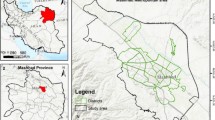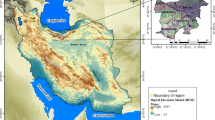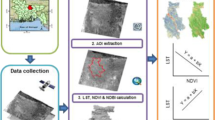Abstract
Land surface temperature and moisture are central components of the Earth’s surface heat budget. China has experienced substantial land use/cover change that has led to deterioration of the urban microclimate, thus affecting global climate change. Understanding the spatial non-stationarity in the relationships between climate and land cover across a highly heterogeneous surface of urban landscapes is important for improving urban planning and management. This study used Landsat-8 OLI/TIRS data to explore the relationship of the three components (index-based built-up index (IBI); bare soil index (SI); and normalized difference vegetation index (NDVI)) with the urban climate (land surface temperature (LST) and land surface moisture (LSM)) using both a global model (ordinary least squares (OLS)) and a local model (geographically weighted regression (GWR)) for a megacity in Southeast China. The global regression results showed that there were significant positive correlations between the LST and the IBI and SI, while significant negative correlations were observed between the LST and the NDVI; opposite results were observed for the LSM. The IBI is the factor having the greatest impact on the LST, while the SI is among the most important factors for the LSM. The local regression results showed that the response of urban climate to land surface is affected greatly by water areas, but the role of the water areas is impacted by their size and surrounding landscape patterns. Moreover, the effects of vegetation and built-up land on the urban climate vary across locations with different wind patterns.







Similar content being viewed by others
References
Ali, R. R., & Shalaby, A. (2012). Response of topsoil features to the seasonal changes of land surface temperature in the arid environment. International Journal of Soil Science, 7, 39–50.
Amiri, R., Weng, O., Alimohammadi, A., & Alavipanah, A. (2009). Spatial-temporal dynamics of land surface temperature in relation to fractional vegetation cover and land use/cover in the Tabriz urban area, Iran. Remote Sensing of Environment, 113, 2606–2617.
Barros, V. R., Field, C. B., Dokken, D. J., Mastrandrea, M. D., Mach, K. J., Bilir, T. E., Chatterjee, M., Ebi, K. L., Estrada, Y. O., Genova, R. C., Girma, B., Kissel, E. S., Levy, A. N., MacCracken, S., Mastrandrea, P. R., & White, L. L. (eds). (2014). IPCC, 2014: climate change 2014: impacts, adaptation, and vulnerability. Part B: regional aspects. Contribution of working group II to the fifth assessment report of the intergovernmental panel on climate change. Cambridge: Cambridge University Press.
Buyantuyev, A., & Wu, J. (2010). Urban heat islands and landscape heterogeneity: linking spatiotemporal variations in surface temperatures to land-cover and socioeconomic patterns. Landscape Ecology, 25, 17–33.
Cai, Y. L., Chen, G., Wang, Y. L., & Yang, L. (2017). Impacts of land cover and seasonal variation on maximum air temperature estimation using MODIS imagery. Remote Sensing, 9, 233.
Core Writing Team (CWT), Pachauri, R. K., & Meyer, L. A. (2014). Climate change 2014. Synthesis report. Contribution of Working Groups I, II and III to the Fifth Assessment Report of the Intergovernmental Panel on Climate Change. Geneva: Intergovernmental Panel on Climate Change (IPCC).
Dickinson, K. L., Monaghan, A. J., Rivera, I. J., Hu, L., Kanyomse, E., Alirigia, R., Adoctor, J., Kaspar, R. E., Oduro, A. R., & Wiedinmyer, C. (2017). Changing weather and climate in northern Ghana: comparison of local perceptions with meteorological and land cover data. Regional Environmental Change, 17(3), 915–928.
Eckert, S., Hüsler, F., Liniger, H., & Hodel, E. (2015). Trend analysis of MODIS NDVI time series for detecting land degradation and regeneration in Mongolia. Journal of Arid Environments, 113, 16–28.
Estoque, R. C., Murayama, Y., & Myint, S. W. (2017). Effects of landscape composition and pattern on land surface temperature: an urban heat island study in the megacities of Southeast Asia. Science of the Total Environment, 577, 349–359.
Foley, J. A., De Fries, R., Asner, G. P., Barford, C., Bonan, G., Carpenter, S. R., Chapin, F. S., Coe, M. T., Daily, G. C., Gibbs, H. K., Helkowski, J. H., Holloway, T., Howard, E. A., Kucharik, C. J., Monfreda, C., Patz, J. A., Prentice, I. C., Ramankutty, N., & Snyder, P. K. (2005). Global consequences of land use. Science, 309, 570–574.
Fotheringham, A. S., Charlton, M. E., & Brunsdon, C. (2016). Geographically weighted regression: a natural evolution of the expansion method for spatial data analysis. Environment and Planning A, 30, 1905–1927.
Fuller, D. O. (1998). Trends in NDVI time series and their relation to rangeland and crop production in Senegal, 1987–1993. International Journal of Remote Sensing, 19, 2013–2018.
Fung, T., & Siu, W. (2000). Environmental quality and its changes, an analysis using NDVI. International Journal of Remote Sensing, 21, 1011–1024.
Goetz, S. J., Prince, S. D., & Small, J. (2000). Advances in satellite remote sensing of environmental variables for epidemiological applications. Advances in Parasitology, 47, 289–307.
Guo, Z., Wang, S. D., Cheng, M. M., & Shu, Y. (2012). Assess the effect of different degrees of urbanization on land surface temperature using remote sensing images. Procedia Environmental Sciences, 13, 935–942.
Hereher, M. E. (2017). Effect of land use/cover change on land surface temperatures—the Nile Delta, Egypt. Journal of African Earth Sciences, 126, 75–83.
Hu, X. S., & Xu, H. (2018). A new remote sensing index for assessing the spatial heterogeneity in urban ecological quality: a case from Fuzhou City, China. Ecological Indicators, 89, 11–21.
Hu, X. S., Hong, W., Qiu, R. Z., Hong, T., Chen, C., & Wu, C. Z. (2015). Geographic variations of ecosystem service intensity in Fuzhou city, China. Science of the Total Environment, 512, 215–226.
Kerr, Y. H., Waldteufel, P., Wigneron, J. P., Martinuzzi, J., Font, J., & Berger, M. (2001). Soil moisture retrieval from space: the soil moisture and ocean salinity (SMOS) mission. IEEE Transactions on Geoscience and Remote Sensing, 39(8), 1729–1735.
Kilic, A., Allen, R., Trezza, R., Ratcliffe, I., Kamble, B., Robison, C., & Ozturk, D. (2016). Sensitivity of evapotranspiration retrievals from the METRIC processing algorithm to improved radiometric resolution of Landsat 8 thermal data and to calibration bias in Landsat 7 and 8 surface temperature. Remote Sensing of Environment, 185, 198–209.
Li, J., Wang, X., Wang, X., Ma, M., & Zhang, H. (2009). Remote sensing evaluation of urban heat island and its spatial pattern of the Shanghai metropolitan area, China. Ecological Complexity, 6, 413–420.
Lowry, W. P. (1977). Empirical estimation of the urban effects on climate: a problem analysis. Journal of Applied Meteorology, 16, 129–135.
Ma, Q., Wu, J., & He, C. (2016). A hierarchical analysis of the relationship between urban impervious surfaces and land surface temperatures: spatial scale dependence, temporal variations, and bioclimatic modulation. Landscape Ecology, 31, 1139–1153.
Malbéteau, Y., Merlin, O., Gascoin, S., Gastellu, J. P., Mattar, C., Olivera-Guerra, L., Khabba, S., & Jarlan, L. (2017). Normalizing land surface temperature data for elevation and illumination effects in mountainous areas: a case study using aster data over a steep-sided valley in Morocco. Remote Sensing of Environment, 189, 25–39.
Mo, M. C., & Lettenmaier, D. P. (2014). Hydrologic prediction over the conterminous United States using the national multi-model ensemble. Journal of Hydrometeorology, 15, 1457–1472.
Muttitanon, W., & Tripathi, N. (2005). Land use/land cover changes in the coastal zone of Ban Don Bay, Thailand using Landsat 5 TM data. International Journal of Remote Sensing, 26, 2311–2323.
Nes, E. H. V., Scheffer, M., Brovkin, V., Lenton, T. M., Ye, H., Deyle, E., & Sugihara, G. (2015). Causal feedbacks in climate change. Nature Climate Change, 5, 445–448.
Nguyen, O. V., Kawamura, K., Trong, D., Gong, Z., & Suwandana, E. (2015). Temporal change and its spatial variety on land surface temperature and land use changes in the Red River Delta, Vietnam, using MODIS time-series imagery. Environmental Monitoring and Assessment, 187, 1–11.
Oke, T. R. (1982). The energetic basis of the urban heat island. Quarterly Journal of the Royal Meteorological Society, 108, 1–24.
Pichierri, M., Bonafoni, S., & Biondi, R. (2012). Satellite air temperature estimation for monitoring the canopy layer heat island of Milan. Remote Sensing of Environment, 127, 130–138.
Pielke, R. A., Pitman, A., Niyogi, D., Mahmood, R., McAlpine, C., Hossain, F., Goldewijk, K. K., Nair, U., Betts, R., Fall, S., Reichstein, M., Kabat, P., & Noblet, N. (2011). Land use/land cover changes and climate: modeling analysis and observational evidence. WIREs Climate Change, 2, 828–850.
Poudyal, N. C., Johnson-Gaither, C., Goodrick, S., Bowker, J. M., & Gan, J. B. (2012). Locating spatial variation in the association between wildland fire risk and social vulnerability across six southern states. Environmental Management, 49, 623–635.
Rajasekar, U., & Weng, Q. (2009). Urban heat island monitoring and analysis using a non-parametric model: a case study of Indianapolis. ISPRS Journal of Photogrammetry and Remote Sensing, 64, 86–96.
Rikimaru, A., Roy, P. S., & Miyatake, S. (2002). Tropical forest cover density mapping. Tropical Ecology, 43, 39–47.
Sahebjalal, E., & Dashtekian, K. (2013). Analysis of land use land covers changes using normalized difference vegetation index (NDVI) differencing and classification methods. African Journal of Agriculture Research, 8, 4614–4622.
Seddon, A. W. R., Macias-Fauria, M., Long, P. R., Benz, D., & Willis, K. J. (2016). Sensitivity of global terrestrial ecosystems to climate variability. Nature, 531(7593), 229–232.
Shamir, E., & Georgakakos, K. P. (2014). MODIS land surface temperature as an index of surface air temperature for operational snowpack estimation. Remote Sensing of Environment, 152, 83–98.
Srivastava, P. K., Majumdar, T. J., & Bhattacharya, A. K. (2009). Surface temperature estimation in Singhbhum Shear Zone of India using Landsat-7 ETM-f thermal infrared data. Advances in Space Research, 4, 1563–1574.
Stewart, I. D. (2000). Influence of meteorological conditions on the intensity and form of the urban heat island effect in Regina. Canadian Geographer, 44, 271–285.
Stocker, T. F., Qin, D., Plattner, G. K., Tignor, M., Allen, S. K., Boschung, J., Nauels, A., Xia, Y., Bex, V., & Midgley, P. M. (2013). Summary for policymakers. In climate change 2013: the physical science basis. Contribution of Working Group I to the Fifth Assessment Report of the Intergovernmental Panel on Climate Change. Cambridge: Cambridge University Press.
Sun, Z. D., Chang, N. B., & Opp, C. (2010). Using SPOT-VGT NDVI as a successive ecological indicator for understanding the environmental implications in the Tarim River basin, China. Journal of Applied Remote Sensing, 4, 844–862.
Voogt, J., & Oke, T. (2003). Thermal remote sensing of urban climates. Remote Sensing of Environment, 86, 370–384.
Wanders, N., Bierkens, M. F. P., de Jong, S. M., & de RooA, K. D. (2014). The benefits of using remotely sensed soil moisture in parameter identification of large-scale hydrological models. Water Resources Research, 50, 6874–6891.
Waylen, P., Southworth, J., Gibbes, C., & Tsai, H. (2014). Time series analysis of land cover change: developing statistical tools to determine significance of land cover changes in persistence analyses. Remote Sensing, 6, 4473–4497.
Weng, Q. (2009). Thermal infrared remote sensing for urban climate and environmental studies: methods, applications, and trends. ISPRS Journal of Photogrammetry and Remote Sensing, 2009(64), 335–344.
Weng, Q., Lu, D., & Schubring, J. (2004). Estimation of land surface temperature-vegetation abundance relationship for urban heat island studies. Remote Sensing of Environment, 89, 467–483.
Wilson, J. S., Clay, M., Martin, E., Stuckey, D., & Vedder-Risch, K. (2003). Evaluating environmental influences of zoning in urban ecosystems with remote sensing. Remote Sensing of Environment, 86, 303–321.
Winckler, J., Reick, C. H., & Pongratz, J. (2017). Why does the locally induced temperature response to land cover change differ across scenarios? Geophysical Research Letters, 44, 3833–3840.
Xu, H. Q. (2006). Modification of normalised difference water index (NDWI) to enhance open water features in remotely sensed imagery. International Journal of Remote Sensing, 27, 3025–3033.
Xu, H. Q., Ding, F., & Wen, X. L. (2009). Urban expansion and heat island dynamics in the Quanzhou region, China. IEEE Journal of Selected Topics in Applied Earth Observations and Remote Sensing, 2, 1939–1404.
Xu, H. Q., Huang, S. L., & Zhang, T. J. (2013). Built-up land mapping capabilities of the ASTER and Landsat ETM+ sensors in coastal areas of southeastern China. Advances in Space Research, 52, 1437–1449.
Yuan, F., & Bauer, M. E. (2007). Comparison of impervious surface area and normalized difference vegetation index as indicators of surface urban heat island effects in Landsat imagery. Remote Sensing of Environment, 106, 375–386.
Zawadzki, J., Cieszewski, C. J., Zasada, M., & Lowe, R. C. (2005). Applying geostatistics for investigations of forest ecosystems using remote sensing imagery. Silva Fennica, 39, 599–618.
Zha, Y., Gao, J., & Ni, S. (2003). Use of normalized difference built-up index in automatically mapping urban areas from TM imagery. International Journal of Remote Sensing, 24, 583–594.
Zhou, D., Zhang, L., Li, D., Huang, D., & Zhu, C. (2016). Climate-vegetation control on the diurnal and seasonal variations of surface urban heat islands in China. Environmental Research Letters, 11, 074009.
Zhuo, L., Dai, Q., & Han, D. (2015). Evaluation of SMOS soil moisture retrievals over the central United States for hydro-meteorological application. Physics and Chemistry of the Earth, Parts A/B/C, 83-84, 146–155.
Funding
This research was funded by the China Postdoctoral Science Foundation (no. 2017M610390), the National Natural Science Foundation of China (no. 41201100), and the Natural Science Foundation of Fujian Province (no. 2015J01606), to which we are very grateful.
Author information
Authors and Affiliations
Corresponding author
Ethics declarations
Conflict of interest
The authors declare that there is no conflict of interest.
Additional information
Publisher’s note
Springer Nature remains neutral with regard to jurisdictional claims in published maps and institutional affiliations.
Rights and permissions
About this article
Cite this article
Hu, X., Xu, H. Spatial variability of urban climate in response to quantitative trait of land cover based on GWR model. Environ Monit Assess 191, 194 (2019). https://doi.org/10.1007/s10661-019-7343-1
Received:
Accepted:
Published:
DOI: https://doi.org/10.1007/s10661-019-7343-1




